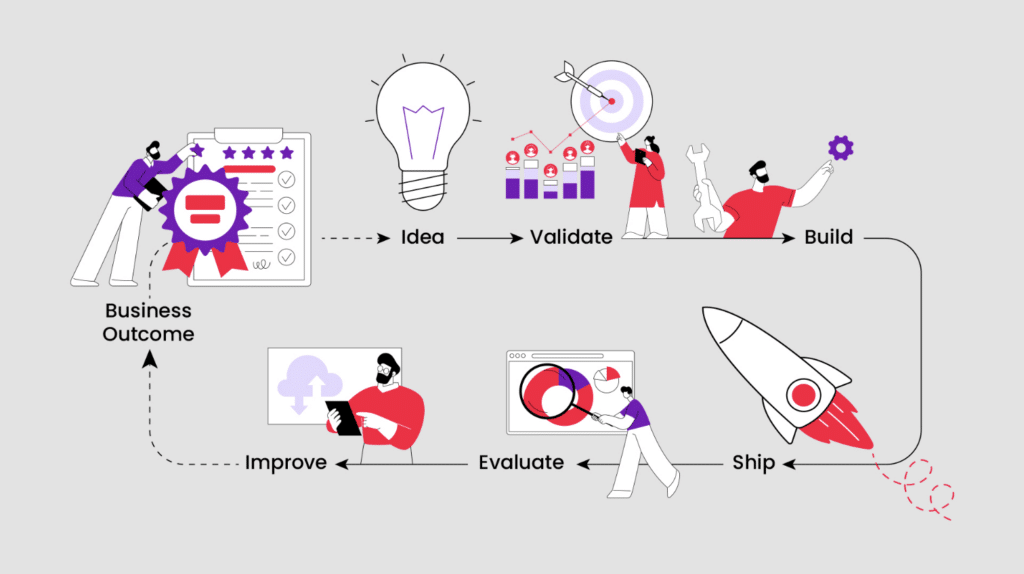
Intro
One of the most mystifying aspects of Product Management is figuring out how to proactively lead your team towards goals that deliver real impact for your company and customers. It’s easy to fall into a trap of reacting to the hundreds of requests, Slack messages, and Jira tickets – creating a discombobulated backlog of random requests while never really moving the needle. This juggling act can overwhelm the most well-meaning Product Managers. What should you say “yes” to? What can you say “no” to?
What is the purpose of a product strategy?
Product Managers lead by influence, not authority. We have to convince our stakeholders – through sound data and logic – that our proposals and plans make sense. Day to day, we encounter a ton of information and opinions. In order to create clarity and direction for the team, our job is to synthesize various inputs, recognize patterns, and ultimately define a product strategy that our many stakeholders believe in.
Once this path is set and our stakeholders are bought in, it’s a bit easier to de-emphasize or de-prioritize ideas and problems that don’t serve the product strategy. Your vision and strategy become a lens you can use to view product requests through. Ask yourself, “does this request bring us closer to, or farther from, our shared vision?”
Having a clear plan creates more stability in the short term, allowing teams to focus on delivering the smaller projects that serve a larger goal.
Step 0: Understanding your customers, company, and opportunities
- Become an expert in why your customers use your product (or why some don’t!)
- What trends do you observe? What are the most common use cases? Where does your product fall short? What has caused customers to churn?
- Learn as much as you can about the broader space and competitors
- Where is the market going? What strengths and weaknesses does your product have, in comparison to the alternatives? What differentiators does your product and company have that are hard to replicate?
- Build relationships with customers and customer-facing teams
- Join customer calls, understand the biggest pain points for customer-facing teams, and core use-cases of your product. If you can, shadow customers in real life to gain context on their day-to-day workflows. Understand their high-level concerns, fears, and goals.
- Get clear on your company’s key metrics and measurements of success
- What defines success at your company? Product doesn’t exist in a silo – it’s one of the many tools your company has to increase revenue and invest in its customers. Understand how your company is measuring and reporting on revenue, operations, customer success, etc.
Step 1: Start with a Vision
Most tech companies have a product “vision” that defines the future state of the world and how their company will help achieve it. Company visions are usually quite broad and cover the span of many years.
Some examples:
- Zoom: “Make communications frictionless and secure”
- LinkedIn: “Create economic opportunity for every member of the global workforce.”
- Google: “Organize the world’s information and make it universally accessible and useful.”
- Artera: “Make Healthcare #1 in Customer Service”
These company-product visions are motivating and inspirational, but are (intentionally) too broad to be actionable by individual teams, who require focus and direction.
To bring context to these statements and break them down into more tactical parts, each product within a company should also have a “vision” that defines an ideal state that illustrates the most positive outcome. These should support the higher-level company vision, but tell a more specific story about the customers and capabilities of a particular product area.
Let’s focus on Artera’s Bulk Messaging products (my area of focus!) – Campaigns and Broadcasts.
Based on our understanding of our customers (Step 0!), competitors, and company’s unique position, we came up with the following Vision for Bulk Messaging:
Artera Bulk Messaging enables care teams to orchestrate messaging to dynamic, tailored populations, driving measurable action.
Those familiar with Artera’s Bulk Messaging products may say that our products and services fall short of delivering on this vision today. However, we know that IF this vision statement was true, we would be delivering much more value for customers and Artera.
Step 2: Define your obstacles
Now that we have our vision – we need to identify what specific obstacles we face that prevent us from achieving it. These include both internal or external obstacles.
In this case, we are working with knowledge of how our products work today, and can articulate what shortcomings and problems customers face when trying to achieve the vision statement above:
Here’s a sample of obstacles that we defined:
- Campaign and Broadcast audience building is difficult and manual
- Lack of patient continuity between Bulk Messaging and Conversational Messaging
- Campaign/Broadcast success is hard to track and quantify
Internally, we add a lot of (super secret!) details and context around these problem statements, which can lead us to defining and prioritizing our product strategy – steps to achieving our product vision.
Step 3: Define the Strategy
Creating a strong product strategy defines the “steps” or “signposts” that tell us we’re on our path to achieving our vision. Each strategic step should have clear measurement indicators that it has been achieved.
Each step articulates what needs to be done to overcome the obstacles outlined earlier. Within each step, specific initiatives or projects can be listed – these help teams connect their contributions with the larger vision and strategy.
Opinions diverge as to whether multiple steps may be worked on in parallel; in my mind – they can be (unless of course, a project is blocked by previous work). Sequencing and roadmapping should be determined through collaboration with your engineering and design counterparts – prioritizing initiatives across your product strategy based on relative value and effort.
For our example above, we landed on the following strategic steps to help us achieve our vision:
- Alleviate manual work in Campaign creation
- Launch Pulse Outreach to offer “set and and forget it” Campaign creation/sending
- Unblock easier audience selection in Campaigns by adding audience builder in app
- Demonstrate ROI via Campaign Goals
- Allow flexible goal-setting per campaign
- Aggregate % goals achieved across campaigns
- Visualize deliverability and performance in-app
- Create easier paths for following up with Campaign/Broadcast recipients
- Deliver seamless communication workflows across applications
- Allow bulk messages to be delivered via High-Volume Number or Practice Lines to deliver more seamless conversations between healthcare systems and patients
- Define additional tools for expanded use cases and increased customer value (redacted for secrecy)
A product strategy should be a living document that is revisited every 6-12 months as projects are completed, more is learned, and context evolves. It’s important to get feedback on the product strategy by stress-testing it: Are we missing a critical component? Are we able to achieve our goals and metrics if we complete these steps? Will these strategic steps actually help solve the obstacles we face?
Once you have a draft product strategy, shop it around with stakeholders. Does it clarify the “why?” Does it get your team excited about working on the strategy? Does it concern or relieve your sales team members?
Step 4: Measure progress
For each initiative, metrics should be defined and tracked that help tie your work to department and company KPIs.
For each round of strategic planning, assess whether your recently-released products are performing against your defined KPIs. Do you need to pivot? Can you double down on your strategy? Overall product health metrics and company KPIs can provide a helpful window into whether your assumptions are correct – the numbers don’t lie.
Step 5: Repeat, repeat, repeat
Every time you share a quarterly roadmap or meet with your stakeholder groups, remind them of your product strategy and vision. Be receptive to feedback and create openings for revisions as you learn more. If a major customer problem or feature request arises (Churn risk! Executive ask! Things on fire!), point to your strategy and ask – “is this important enough to put our product strategy at risk?” In some cases, it will be – and being collaborative and flexible is the best approach. However, the product strategy may serve as a reminder that the larger vision is more important than a tempting distraction.
Revisit your product strategy at least every 6 months, incorporating new learnings and adjusting as new products and features get launched.
In conclusion…
The exercise of creating a product strategy and vision will likely force some important (and perhaps philosophical) conversations with colleagues and customers. Lean in to misalignments when you detect them and work through them to arrive at a shared understanding.
At the end of each vision/strategy refresh, you will hopefully have a renewed sense of excitement for the set of problems your team is setting out to solve. I feel particularly proud to work on products that serve healthcare systems and patients to solve their communication struggles!
The content provided on this blog is for informational purposes only and does not constitute professional advice. While we strive to offer accurate and up-to-date information about the ever-growing field of healthcare technology, the information may not be applicable to your specific circumstances. Always consult a qualified professional. Artera is not responsible for any decisions made based on the information provided here.




